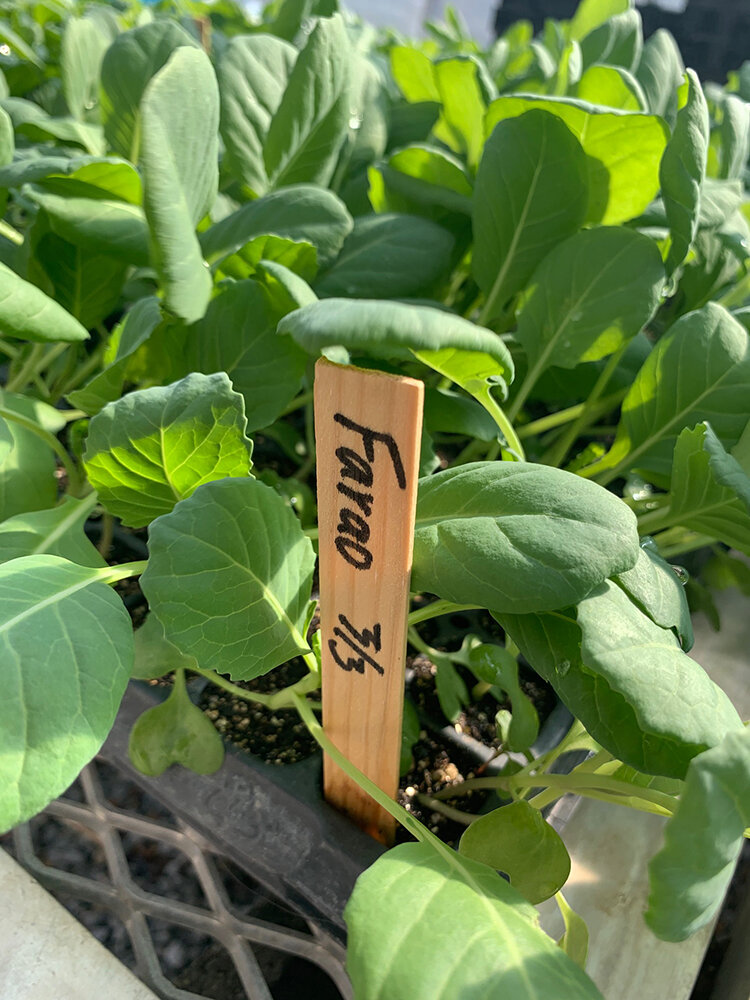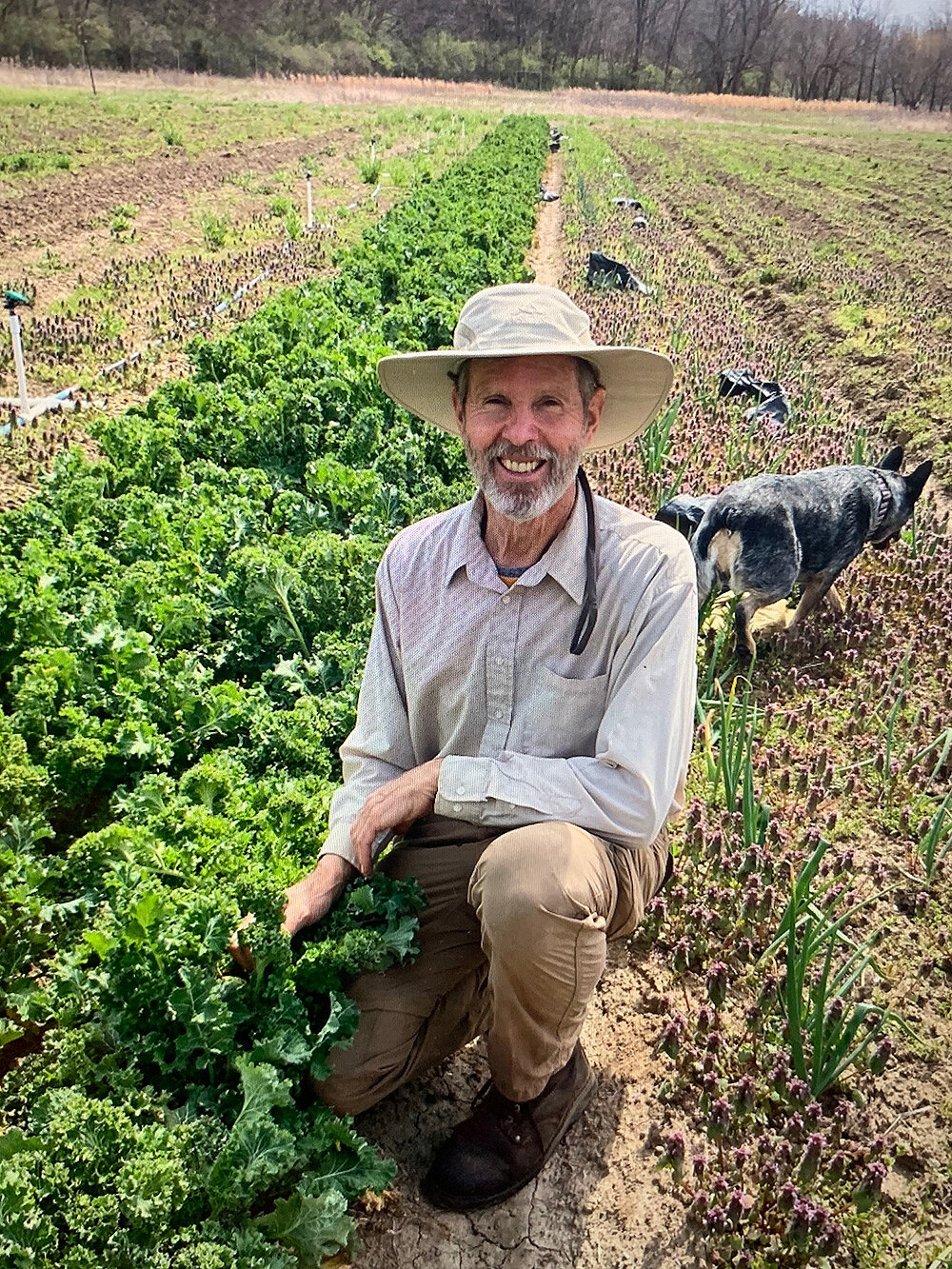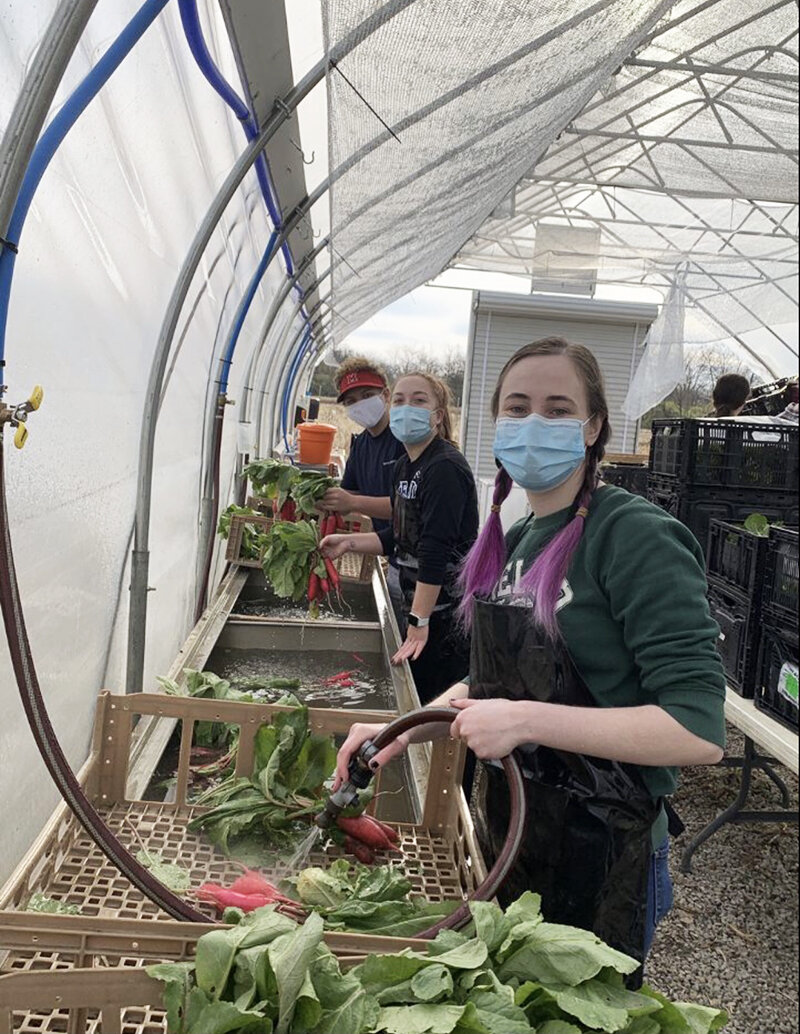Growing Community
Charles Griffin bring lifetime of agricultural expertise to the Miami farm
By Fiona Lawler
Meet the heart, soul and roots of the Miami University farm.
Charles Griffin, age 67, has been director of farm operations since 2017. With more than 20 years of experience, this organic growing expert says he is dedicated to the success of Miami’s Institute for Food and its 8 acres under crop.
But the future of this sustainably managed property on Somerville Road is in jeopardy.
Closing it would dismay the hundreds of students over the past five years who have learned organic growing techniques from a master, and leave future students without this special place for experiential learning.
During the pandemic, especially, students say they greatly enjoyed seeding,
planting, harvesting and packaging the farm’s seasonal vegetables as a counterpoint to Zoom.
Much of that joy sparked from Griffin, who lives in Enright Urban EcoVillage in Cincinnati.
Here’s his story.
‘Nature speaks to me’
At a young age, Griffin felt a strong connection to nature. Growing up in Saratoga, California, he often went camping and spent his time outdoors. He visited the world-renowned farm and gardens at University of California Santa Cruz as a young man and was inspired to pursue a career in agriculture.
After graduating high school, Griffin moved to England for five years, participating in its Rural Development Programme. Here, he learned first-hand how to grow, harvest, and cook sustainable crops and meals.
After returning from England, he studied agriculture at UC Santa Cruz.
"I felt I had been called to the pursuit of understanding nature as it speaks to me," says Griffin.
He used this academic and hands-on knowledge to help develop other organic farms. Griffin then moved to Cincinnati, where he was a mentor at the urban Findlay Market and taught in the sustainable agriculture program at Cincinnati State Community College.
Griffin believes he was destined to meet Marguerite Shaffer, Ph.D., the Miami professor whose dream it was to begin the Institute for Food, which she did in 2016. Griffin agreed to oversee farm operations on a portion of the historic, 35-acre Austin-Magie Farm and Mill District, just beyond Yager Stadium.
He began commuting from his home at Enright Urban Ecovillage in Cincinnati, where residents share community sustained gardens.
CSAs, salsa and pasta sauce
But after Shaffer's departure from Miami for personal reasons in 2020, the Institute for Food fell into a precarious financial situation. Shaffer had won grants, worked to establish food science and food culture courses, established the farm’s Community Supported Agriculture program, and produced commercial products like salsa and pasta sauce.
Without her, no faculty member was at the helm of the farm, no leading voice was advocating on campus and surrounding communities.
This left Griffin doing the brunt of the farm work himself, with occasional hired farm help, and students participating in experiential learning for class, or volunteering.
Managing daily operations, growing and harvesting, irrigation, and farm finances has been challenging, Griffin explains.
When the pandemic hit in spring 2020, university finances became strained.
Was a farm a necessity for optimal student learning at a liberal arts college?
My conversations with Griffin took place in spring 2021 over several days at the farm; in Boyd Hall, where seedlings are grown; and other places.
While this article was a project for my Miami Environmental Journalism class, Griffin’s story reveals the universal struggle between a desire for clean, local food and the hard work it takes to produce it; between love of the land and fiscal reality; between bureaucracy and beauty.
‘An empty field’
I ask Griffin what inspired him to take this job, and how he began developing the Miami farm.
"The Miami Institute for Food is my little way of saving the world," Griffin replies.
But before his arrival, the acreage was discarded farmland, edged by two then-dilapidated houses.
"It was just an empty field when I came. The soil was absolutely beaten to death," says Griffin with a chuckle.
He would soon change this.
“With the help of volunteers, I built up the soil, put up solar panels, instant storage, and set up a washroom for crops that also serves as a place to house them before transportation,” he explains.
“In 2018, we put the fence up and purchased a tractor for plowing. Not long after this had been accomplished, we started producing crops," Griffin says, pointing some of these out as he speaks.
Crops must be sold or donated.
This is where the farm’s Community Supported Agriculture (CSA) program comes into play. Beginning with just 30-40 members per year, it grew to about 150 members in 2020 - students, faculty, staff and other Oxford residents.
I ask Griffin to explain what kinds of crops the farm grows, and why he chose them.
Also, how does the work day change with the seasons?
Spring and fall, he explains, yield similar crops that are customer favorites, such as lettuce, spinach, turnips, radishes, beets, carrots, cabbage and kale.
Summer crops include tomatoes, peppers, cucumbers and flowers.
In March, Griffin was planting cabbage and bok choy to be harvested in late May. It is always this seesaw of planting and reaping for small farms.
Normally, Griffin will arrive at the farm at 10 a.m. to meet students, plant, inspect crop rows, harvest and wash vegetables.
In spring 2021, the new washroom wasn’t completely finished - it needs two end walls. But this is where the bulk of work was taking place, as the Boyd Hall Greenhouse (located on-campus) is often full.
Thursday is CSA distribution day, so packing gets underway. These days are long, and often 10 to 12 volunteers help Griffin get the CSA yields this week to Cook Field, where members arrive with their own bags to choose their products.
"This method is more connected, as it meets (members’) personal preferences and palates," Griffin says passionately.
This was running smoothly until the Covid-19 global pandemic hit. But Griffin, looking at the situation with the glass half-full, says CSA membership actually increased, as more people wanted to cook healthy meals while at home.
Distribution became socially distanced, and now there is a drive-through option for CSA members to get their produce weekly.
Click the link below to find the full list of all crops grown at the Miami Institute for Food, along with health benefits, how to use each crop and recipes associated with each.
https://www.miamioh.edu/cas/academics/centers/iff/our-farm/crops/index.html
Growing vegetables, but thinking of nutrition
I ask Griffin about the challenges he faces growing crops sustainably at the farm.
He replies that there are both human and environmental factors to consider. For example, the CSA offering is once a week, and the farm constantly needs a variety of crops to deliver.
"There needs to be a balance between fruits, roots, and flowers in order to nutritionally cover the bases," says Griffin.
Nutrition is one of Griffin's motivating factors for farming, and an aspect to which he is most emotionally connected.
Besides the CSA demand, environmental challenges include mice, rabbits, raccoons, and deer, according to Griffin. The Oxford water supply is also a bit problematic, as it is filled with calcium, which crops don’t necessarily love.
I’m curious about Griffin’s passion for sustainable agriculture methods.
“My motivation has changed over the years,” replies Griffin.
In the beginning of his career, that motivation was seeing a plant grow from seed to something healthy that nourishes the body.
But now his interest has expanded into physiology and disease prevention.
"When you eat good food, you can think more clearly and make better decisions, such as realizing we have to save the environment," says Griffin. Also, "I want people to recognize and learn the negative effects of eating bad food and a poor diet.
"I've seen a lot of family and friends suffer from heart disease, arthritis, irritations and inflammations that all could have been controlled by different dietary choices," Griffin explains, in a serious tone.
So he works hard to educate students, CSA members and friends on why they should consume healthy, organically sourced food.
"Food is medicine," he says firmly.
To grow sustainably, Miami farm builds soil quality, rotates crops
At the Miami farm, Griffin uses sustainable and organic practices.
What does that look like at the Miami farm, I ask Griffin.
"There are three legs to sustainable agriculture: environmental stewardship, social responsibility, and financial viability," he replies.
Some examples?
Griffin builds soil sustainably, uses fertilizer that does not harm the environment, leaves dead crops on top of the soil to prevent erosion, uses crop rotation to ensure biodiversity, eschews pesticides, uses solar power and cultivates weeds to promote wildlife.
"While it is more costly to do all this, at least my crops aren't contaminated," Griffin says.
He pays special attention to insects and wildlife.
"I allow insects to flourish, but for a purpose," Griffin says, launching into an explanation of managing insects.
For example, Griffin allows crops to flower, attracting certain insects. He allows hoverflies (closely resembling bees) to lay eggs on the larvae of other insects, so when they hatch, they eat the pests they have been nesting on.
Griffin scatter-feeds birds, which then will eat other insects that could damage crops.
It truly is the circle of life.
One of his dreams is to set up habitat protection zones, where butterflies and bees, frogs and snakes can safely roam, while the farm reaps their far-reaching benefits.
Connecting Miami with the surrounding community
As far as social responsibility and financial viability goes, they are interconnected. Farms require people to work there and be paid, but also people to buy and eat the crops produced. Oxford has a large population of underemployed and underrepresented people, whom students do not always see clearly.
“This is the aspect of farming that is most important… growing community. I would love to engage these people by means of the farm,” says Griffin.
For example, the Miami Institute for Food often donates produce to a local food pantry. But farming operates on narrow profit margins, and "In order to make millions, you have to start with billions," Griffin says.
The farm’s annual budget is about $100,050 per year, including salaries and operational costs. The CSA and other sales bring in $45,000 annually.
Do the math - it’s a significant gap.
Griffin can’t do all this work himself.
Volunteers help. But for the farm to remain viable, Miami must see the value in its experiential learning for students and connecting role in the community. And invest in it.
"The farm can be the catalyst to forge new paths... heal old wounds and start the much-needed conversation regarding health and diet," says Griffin.
He rattles off ideas to establish a learning center at the farm, a garden center and launching annual community celebrations there.
Griffin is a man with expansive ideas, solid experience and a joy for working with students.
Is it enough?
---------------
Fiona Lawler earned bachelor’s degrees in journalism and English literature from Miami University in May 2021.
Photo Credits to Annie-Laurie Blair (image 1 and 2), Fiona Lawler (image 3), and Jenna Landgraf (image 4).




